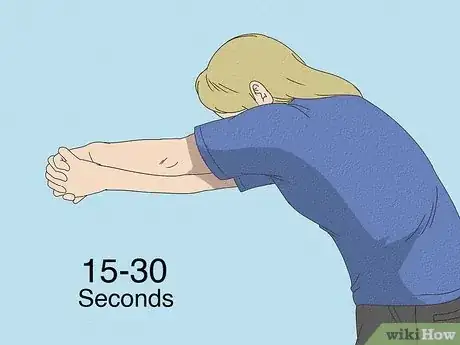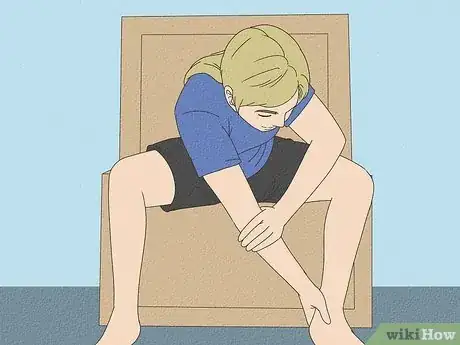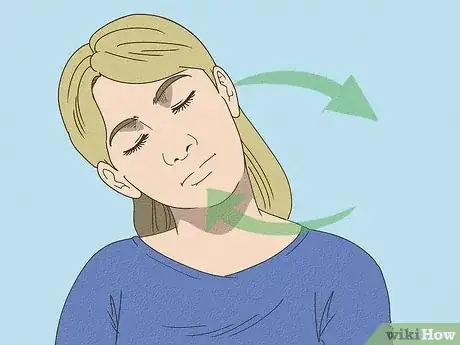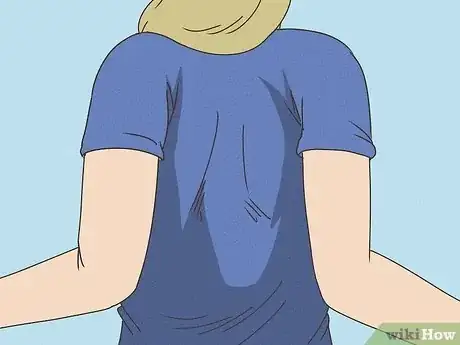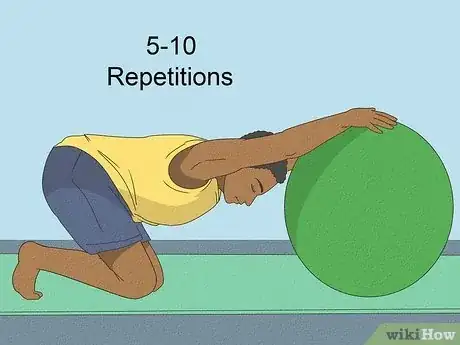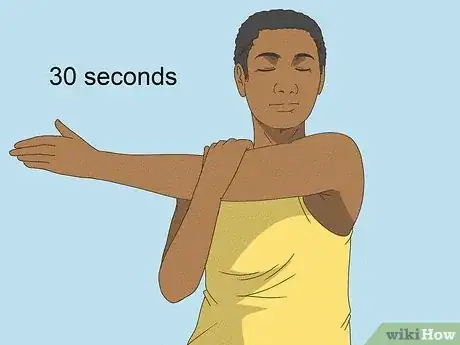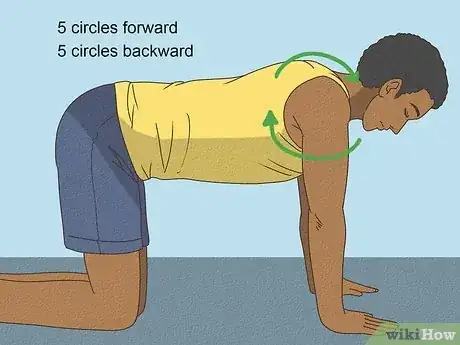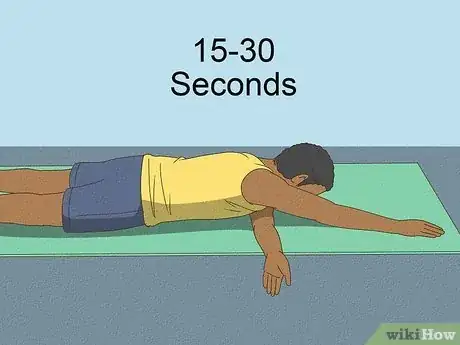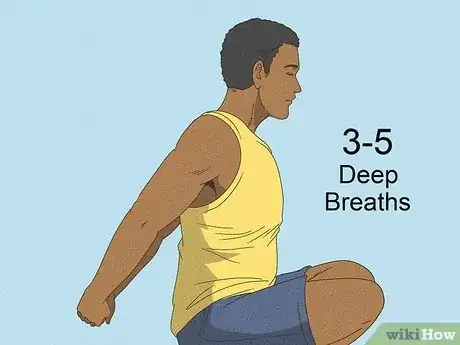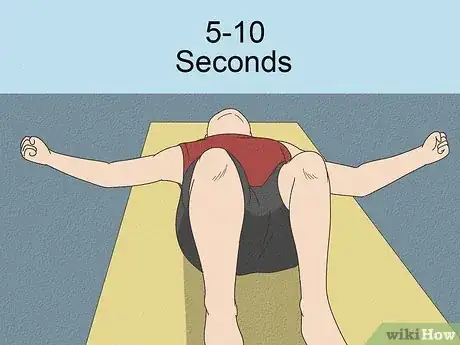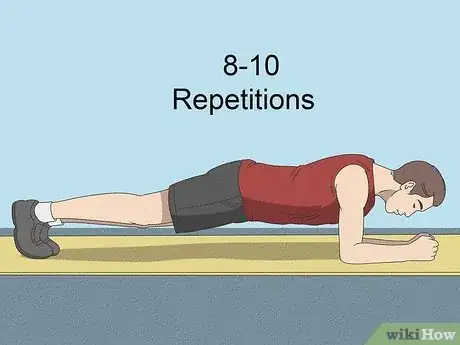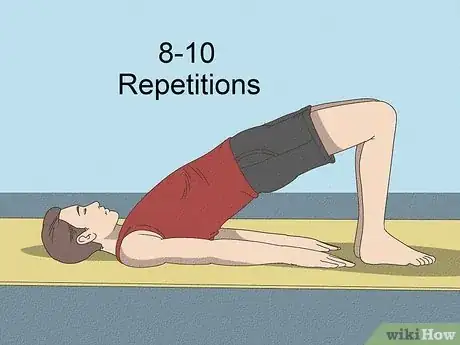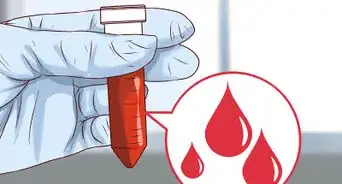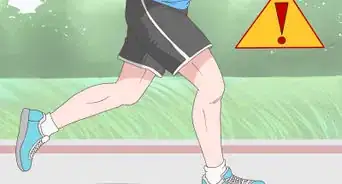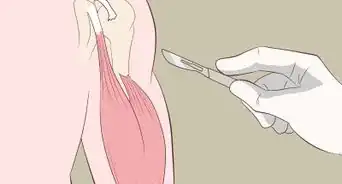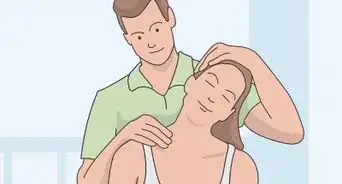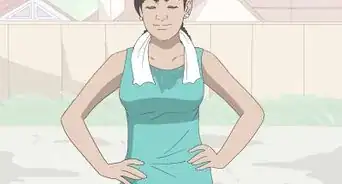This article was co-authored by Brendon Rearick and by wikiHow staff writer, Jennifer Mueller, JD. Brendon Rearick is a Personal Trainer, Strength Coach, Fitness Program Director, and co-founder of Certified Functional Strength Coach (CSFC), a fitness education company in the San Francisco Bay Area. With 17 years of experience in the fitness industry, Brendon specializes in strength and conditioning, and his company CSFC has certified over 3,000 trainers in over 20 countries. Brendon has worked as a Program Director for Mike Boyle Strength and Conditioning (MBSC) and earned his massage therapy license from the Cortiva Institute-Boston. Brendon holds a BS in Kinesiology from the University of Massachusetts Amherst.
There are 11 references cited in this article, which can be found at the bottom of the page.
This article has been viewed 263,979 times.
Rhomboids are deep muscles located in the middle of your back between your spine and your shoulder blades. These muscles help elevate and rotate your shoulder blades. They also pull your shoulder blades toward the spine for good posture. If you have weak or tight rhomboids, you may have a slumping posture, or feel pain in your mid-back between your shoulder blades. Stretching and strengthening your rhomboids will increase shoulder flexibility and mobility and improve your posture.
Steps
Easing Discomfort in Your Rhomboid
-
1Start with a pectoralis stretch. Stand in a corner or open doorway and rest your hands on the walls or door frame slightly above your head. Breathe deeply, and lean forward slowly until you feel a stretch in the front of your shoulders. Hold the stretch for 15 to 30 seconds, continuing to breathe deeply, then release.[1]
- Do 3 repetitions, holding each time for 15 to 30 seconds.
- A weak pectoralis major contributes to that rounded-shoulder posture, and can overload the rhomboid muscles.[2]
-
2Stretch your lower neck and upper back. Stand with your feet about hip-width apart. Stretch your arms in front of you and clasp one hand over the other. Reach out until you feel your shoulder blades pulling away from each other, then bend your head slightly forward. Hold the stretch for 15 to 30 seconds, breathing deeply.[3]
- Repeat the stretch 2 to 4 times, then switch arms so that the hand that was clasped on the bottom is now clasped on the top.
Advertisement -
3Target your rhomboid muscles directly. Sit in a flat, level chair. Move to the edge of the seat so your feet are flat on the floor and your knees are at right angles. Spread your legs a little more than hip-width apart. Reach over and grab your left ankle with your right hand. With your left hand, press into your right elbow crease until you feel a stretch between your spine and shoulder blade on the right side.[4]
- Hold the stretch for 15 seconds, breathing deeply. Then return to start and repeat. Do 2 - 3 repetitions, then switch and do the same stretch on the other side.
-
4Do neck stretches and rotations. To stretch your neck, look straight ahead, then tip your right ear toward your right shoulder. Hold 15 to 30 seconds, then repeat on the other side. For neck rotations, turn your head to the right with your chin level, hold for 15 to 30 seconds, then repeat on the other side.[5]
- Repeat each of these exercises 2 to 4 times on each side. Increasing your neck strength and mobility will reduce pressure and strain on your rhomboids.
- You can do neck stretches and rotations while sitting or standing, whichever is more comfortable for you. If sitting, use a flat chair that allows you to sit up straight with good posture and both feet on the floor.
-
5Contract your rhomboids with a scapular squeeze. While either sitting or standing with your arms by your sides, squeeze your shoulder blades together towards your spine. Hold the squeeze for 5 seconds, then release.[6]
- Do 2 sets of 15 repetitions of this exercise. Make sure you're not holding your breath as you squeeze. Keep your breaths deep and smooth.
Increasing Shoulder Flexibility and Mobility
-
1Start with wall extensions to improve flexibility. Stand with your back and heels flat against a wall. Extend your arms out to either side with the backs of your hands towards the wall. Bend your elbows to 90 degrees, then raise your arms slowly above your head, keeping them flat against the wall.[7]
- Do 2 sets of 5 to 10 repetitions of this exercise. Only go as high as you can without pain, while still keeping your arms, elbows, and wrists against the wall.
- If you have good flexibility, you'll be able to touch your hands together above your head while keeping your arms, elbows, and wrists against the wall at all times.
-
2
-
3Stretch the rotator cuff with cross-arm stretches. Stand with your feet about shoulder-width apart, then pull one arm across your body while also pulling your shoulder blade back. Hold the stretch for 30 seconds, breathing deeply.[10]
- Do 3 repetitions of this stretch, then switch and do the other arm.
- Stretching the rotator cuff will improve the flexibility in your shoulders and decrease the strain on your rhomboid muscles.
-
4Do shoulder circles on your hands and knees. Get down on the floor on all fours with your wrists directly under your shoulders and your knees directly under your hips. Keeping your elbows straight, press into the floor and shrug your shoulders up towards your ears. Then roll your shoulders back towards your hips and back forward, creating a circle.[11]
- Do 5 circles starting forward with both shoulders. Then switch direction and do 5 circles starting backward.
- After doing both shoulders, do 5 each with one shoulder at a time, keeping the other shoulder stable.
-
5Stretch your rotator cuff further with the L-arm stretch. Lie on your stomach and stretch one arm underneath your body and across your chest, palm facing up. Use your shoulder muscles to pull your chest down towards the floor as low as you can without pain. Hold the stretch for 30 seconds, then release.[12]
- Move in and out of the stretched position for 10 reps, holding for 30 seconds each time. Then switch and do the same stretch with the other arm.
- This stretch may feel awkward at first, but play around until you find a comfortable position. For example, you may find this stretch easier if you bend the leg opposite the arm across your chest to open up your hips.
-
6Open your chest with a clasped hands extension. Sit on the floor, or on a chair or bench that doesn't have a back. Clasp your hands palm to palm behind your back, then straighten your elbows. Squeeze your shoulder blades together. Hold the stretch for 15 to 30 seconds, then release.[13]
- Repeat the stretch 5 times, holding each stretch for 15 to 30 seconds. Breathe through the stretch – don't hold your breath.
- This stretch not only improves shoulder position but also builds chest and shoulder muscles to improve your posture.
- Sit in whatever position feels comfortable for you, as long as your hips are balanced and you can sit straight with good posture.
Improving Posture
-
1Counteract hunched shoulders with back bound hand stretches. From a seated or standing position, roll your shoulder blades back and down towards your spine. Bring your arms behind you, grabbing your right elbow with your left hand and your left elbow with your right hand to bind the position. Lift your chest and press your shoulder blades down and together for 3 to 5 deep breaths.[14]
- Switch and do the opposite side, by grabbing your left elbow first with your right hand, and then your right elbow with your left hand. Hold for 3 to 5 deep breaths. Do 2 - 4 repetitions on each side.
- If grabbing your elbow is too difficult or causes pain, you can grab your wrists or forearms.
-
2Open your chest with a supine "T" stretch. Lie on your back on the floor with your knees bent so that your feet are flat on the floor. Extend your arms out straight from your sides to form a "T" shape on the floor. Relax and breathe deeply for 10 minutes.[15]
- You can place a rolled towel or foam roller under your back with the length running down your spine to increase the stretch. Make sure the towel or roller is long enough to support both your head and your hips.
-
3Do planks to strengthen your core. Lie face-down on the floor, then raise up so that your bodyweight is supported by your toes and your elbows with your forearms flat on the floor. Keep your elbows in line with your shoulders. Hold the position for 5 to 10 seconds, breathing deeply. Then release.[16]
- To start, do 8 to 10 repetitions of this exercise. Gradually increase the amount of time you hold the plank.
- Strengthening your core will improve your overall posture and put less stress on your rhomboids.
-
4Try bridges to strengthen your lower back and core. Start on your back with your knees bent so your feet are flat on the floor about shoulder-width apart. Keep your arms flat on the floor at your sides, palms down. Slowly raise your hips gradually until there is a straight line from your knees to your shoulders. Activate your core, and slowly lower yourself back down to start.[17]
- Do 8 to 10 repetitions of this exercise. Make sure you continue to breathe and don't hold your breath.
- Adjust this exercise to meet your fitness level. If you experience pain or discomfort, keep your bridge closer to the ground. You can slowly work up to a full bridge with a straight line through your hips as it feels comfortable for you. Don't rush it.
- You can also treat it like a plank, and try to hold the bridge position for 5 to 10 seconds before releasing. As you continue to practice, gradually increase the time you hold the position.
Expert Q&A
Did you know you can get expert answers for this article?
Unlock expert answers by supporting wikiHow
-
QuestionHow do I stretch my rhomboids?
 Brendon RearickBrendon Rearick is a Personal Trainer, Strength Coach, Fitness Program Director, and co-founder of Certified Functional Strength Coach (CSFC), a fitness education company in the San Francisco Bay Area. With 17 years of experience in the fitness industry, Brendon specializes in strength and conditioning, and his company CSFC has certified over 3,000 trainers in over 20 countries. Brendon has worked as a Program Director for Mike Boyle Strength and Conditioning (MBSC) and earned his massage therapy license from the Cortiva Institute-Boston. Brendon holds a BS in Kinesiology from the University of Massachusetts Amherst.
Brendon RearickBrendon Rearick is a Personal Trainer, Strength Coach, Fitness Program Director, and co-founder of Certified Functional Strength Coach (CSFC), a fitness education company in the San Francisco Bay Area. With 17 years of experience in the fitness industry, Brendon specializes in strength and conditioning, and his company CSFC has certified over 3,000 trainers in over 20 countries. Brendon has worked as a Program Director for Mike Boyle Strength and Conditioning (MBSC) and earned his massage therapy license from the Cortiva Institute-Boston. Brendon holds a BS in Kinesiology from the University of Massachusetts Amherst.
Personal Trainer & Strength Coach
Warnings
- Do not start any new exercise program without first consulting your medical provider, particularly if you have a recent injury.⧼thumbs_response⧽
- If you feel pain when stretching, stop the movement. You should feel a slight stretch, but you should not feel any pain.⧼thumbs_response⧽
References
- ↑ https://www.summitmedicalgroup.com/library/adult_health/sma_rhomboid_muscle_strain_exercises/
- ↑ https://clinicaltrials.gov/ct2/show/NCT04216862
- ↑ https://myhealth.alberta.ca/Health/aftercareinformation/pages/conditions.aspx?hwid=zp4503
- ↑ http://www.stack.com/a/stretches-for-people-who-sit-too-much?slide=4
- ↑ https://myhealth.alberta.ca/Health/aftercareinformation/pages/conditions.aspx?hwid=zp4503
- ↑ https://www.summitmedicalgroup.com/library/adult_health/sma_rhomboid_muscle_strain_exercises/
- ↑ https://www.muscleforlife.com/how-to-improve-shoulder-flexibility-and-mobility/
- ↑ Brendon Rearick. Personal Trainer & Strength Coach. Expert Interview. 12 August 2020.
- ↑ Brendon Rearick. Personal Trainer & Strength Coach. Expert Interview. 12 August 2020.
- ↑ https://www.builtlean.com/2017/01/06/improve-shoulder-flexibility/
- ↑ https://gmb.io/shoulder-mobility/
- ↑ https://gmb.io/shoulder-mobility/
- ↑ https://gmb.io/shoulder-mobility/
- ↑ https://www.prevention.com/fitness/g20489329/7-exercises-that-instantly-un-hunch-your-shoulders/
- ↑ https://www.prevention.com/fitness/g20489329/7-exercises-that-instantly-un-hunch-your-shoulders/
- ↑ https://www.nhs.uk/live-well/exercise/10-minute-abs-workout/#plank
- ↑ https://www.nhs.uk/live-well/exercise/10-minute-firm-butt-workout/#bridges
- ↑ Brendon Rearick. Personal Trainer & Strength Coach. Expert Interview. 12 August 2020.
About This Article
Rhomboids are the muscles between your spine and shoulder blades, and stretching these can improve your shoulder flexibility, mobility, and posture. To target your rhomboids directly, sit on the edge of a chair, bend over, and grab your left ankle with your right hand. Use your left hand to push into your right elbow crease and hold this position for 15 seconds, before repeating it on the other side. You can also do cross-arm stretches to decrease strain on your rhomboids. Stretch one arm across your body while pulling your shoulder blade back and hold it for 30 seconds. Another way to put less strain on your rhomboids is to strengthen your core. Do planks and bridges, and slowly increase the length of time you hold the position. For more information from our Personal Trainer co-author, like how to do pectoral stretches, read on!

